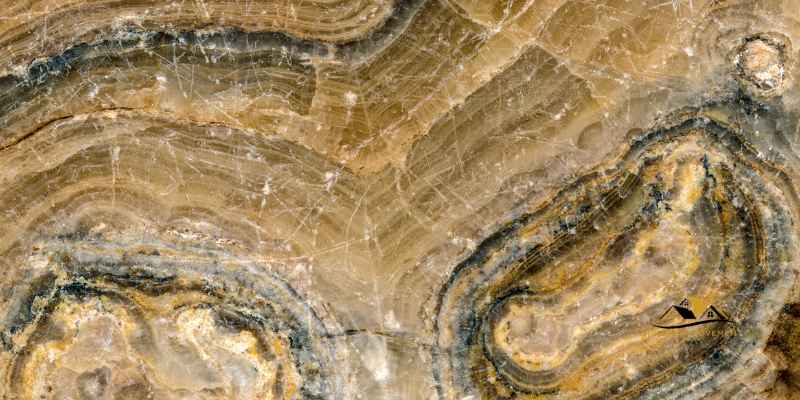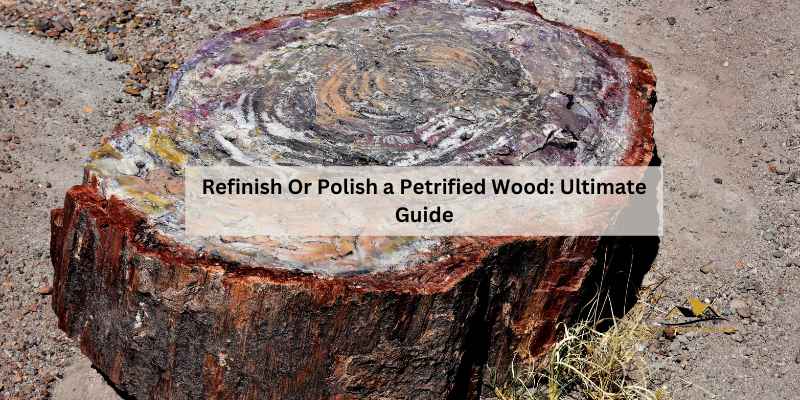To polish petrified wood manually, start with coarse sandpaper and water to sand the piece in a circular motion. Progress through finer grits to remove scratches, then finish with a polishing compound for a high shine.
When cleaning petrified wood, opt for mild cleansers like hand soap or apple cider vinegar to maintain its natural beauty and avoid harsh chemicals. Proper care will help preserve the unique textures and colors of petrified wood, ensuring it looks clean and fresh for years to come.
Whether you’re a collector or simply appreciate the beauty of petrified wood, knowing how to refinish and polish it can enhance its aesthetic appeal and value. By following these steps, you can enjoy the natural beauty of petrified wood in your collection or decor.
Introduction To Petrified Wood Refinishing And Polishing
Petrified wood is a fascinating natural wonder that has been transformed through the process of fossilization. Over time, the organic materials in the wood are replaced with minerals, resulting in a stone-like appearance. While petrified wood is inherently beautiful, refinishing and polishing can enhance its natural allure, bringing out its unique patterns and colors.
What Is Petrified Wood?
Petrified wood is the result of trees or tree-like plants that have turned into stone through the process of petrification. This occurs when organic materials in the wood are replaced by minerals such as quartz, creating a fossilized version of the original wood.
Why Refinish Or Polish?
Refinishing or polishing petrified wood can restore its luster and reveal its intricate grain patterns and vibrant colors. By smoothing out imperfections and enhancing its natural beauty, refinishing and polishing can breathe new life into petrified wood, allowing it to be showcased as a stunning piece of natural art.
Benefits Of Refinishing Or Polishing
- Enhances the natural beauty of petrified wood
- Restores luster and shine
- Reveals intricate grain patterns and vibrant colors
- Preserves the longevity of the wood
Risks Of Refinishing Or Polishing
- Potential damage to the wood if not done carefully
- Loss of natural patina if over-polished
- Exposure to harmful chemicals if not using proper refinishing products
Methods For Refinishing And Polishing Petrified Wood
Refinishing and polishing petrified wood can bring out its natural beauty and enhance its appearance. There are several methods to achieve a polished finish, each with its own techniques and tools.
Manual Polishing
Manual polishing of petrified wood involves using sandpaper and polishing compounds to achieve a smooth and shiny surface. The process requires patience and attention to detail.
Using A Rock Tumbler
Using a rock tumbler is a popular method for polishing petrified wood. The tumbling process involves placing the wood in the tumbler with abrasive grit and water, which gradually smooths and polishes the surface.
Using Chemical Polishes
Chemical polishes can also be used to refinish and polish petrified wood. These polishes often come in liquid form and can help achieve a glossy finish with minimal effort.
Preparing Petrified Wood For Refinishing And Polishing
Cleaning and sanding petrified wood are essential steps in preparing it for refinishing and polishing. Choosing the right polish will enhance the beauty of the wood, bringing out its unique patterns and colors.
Cleaning Petrified Wood
- Use mild cleansers like hand soaps or apple cider vinegar to remove dirt and grime.
- Avoid harsh chemicals that can damage the wood.
Sanding And Smoothing The Surface
- Start with coarse sandpaper in a circular motion.
- Progress to finer grits to remove scratches.
- Finish with a polishing compound for a high shine.
Choosing The Right Polish
Consider factors like the type of petrified wood and the desired finish when selecting a polish. Opt for a high-quality polish that will bring out the natural beauty of the wood.
Manual Polishing Techniques
When it comes to restoring the natural beauty of petrified wood, manual polishing techniques can be an effective way to achieve stunning results. With the right tools and methods, you can enhance the luster and texture of petrified wood, bringing out its unique patterns and colors. Let’s explore the step-by-step process of manual polishing, from using coarse sandpaper to applying polishing compounds.
Using Coarse Sandpaper
To begin the manual polishing process, start with coarse sandpaper and water. Gently sand the petrified wood in a circular motion, applying even pressure to remove any surface imperfections. This initial step helps to smoothen the rough areas and prepare the wood for further polishing.
Progressing To Finer Grits
After using coarse sandpaper, progress to finer grits to refine the surface of the petrified wood. Gradually transition to higher grit sandpapers, systematically eliminating scratches and blemishes. This process requires patience and precision to achieve a smooth and uniform finish.
Applying Polishing Compounds
Once the surface is adequately refined, it’s time to apply polishing compounds to enhance the sheen of the petrified wood. Using a soft cloth, gently rub the polishing compound onto the wood in a circular motion. This final step brings out the natural luster of the wood, creating a glossy and polished appearance.
Using A Rock Tumbler For Polishing Petrified Wood
Enhance the beauty of petrified wood by using a rock tumbler for polishing. Begin with coarse sandpaper, progress through finer grits, and finish with a polishing compound for a stunning shine. Patience and consistent pressure are essential for optimal results.
If you’re looking to achieve a polished look for your petrified wood, using a rock tumbler can be an effective method. A rock tumbler is a machine that uses abrasion to smooth and polish rocks and minerals. Here’s how to use a rock tumbler to polish petrified wood.
Choosing the Right Tumbler
The first step is to choose the right tumbler for your needs. There are two main types of rock tumblers: rotary and vibratory. Rotary tumblers are the most common and are great for polishing larger pieces of petrified wood. Vibratory tumblers are better suited for smaller pieces of petrified wood and can achieve a smoother finish. Consider the size and type of petrified wood you’re working with when choosing a tumbler.
Preparing the Tumbler and Materials
Before you begin the polishing process, you’ll need to prepare the tumbler and materials. Start by cleaning the tumbler barrel thoroughly to remove any debris or residue. Next, add your petrified wood pieces to the barrel, along with coarse grit. The grit will help to smooth and shape the wood. Add water to cover the pieces and turn on the tumbler. Let it run for several days, checking on the progress regularly.
Polishing Process and Timeframe
Once the petrified wood has been shaped and smoothed, it’s time to move on to the polishing process. Remove the coarse grit and replace it with fine grit. Add water and let the tumbler run for several more days. Check the progress regularly to ensure the wood is being polished evenly. Finally, replace the fine grit with a polishing compound and let the tumbler run for a few more days. The end result should be a smooth, polished surface.
In conclusion, using a rock tumbler can be an effective way to polish petrified wood. By choosing the right tumbler, preparing the materials properly, and following the polishing process, you can achieve a beautiful finish for your petrified wood pieces.
Chemical Polishing Techniques
Refinishing or polishing petrified wood using chemical polishing techniques can be an effective way to enhance its natural beauty. These techniques involve using acids and other chemicals to remove imperfections and achieve a smooth, glossy finish. However, it’s important to follow safety precautions and consider the pros and cons of chemical polishing before proceeding.
Using Acids And Other Chemicals
When refinishing petrified wood with chemicals, acids such as hydrochloric acid or oxalic acid can be used to dissolve surface imperfections and reveal the wood’s natural luster. Additionally, other chemicals like polishing compounds and sealers may be applied to further enhance the appearance and durability of the wood.
Safety Precautions
It’s crucial to take proper safety precautions when using chemical polishing techniques. This includes wearing protective gear such as gloves, goggles, and a respirator to prevent exposure to harmful fumes and skin irritation. Adequate ventilation in the work area is also essential to minimize the risk of inhaling toxic vapors.
Pros And Cons Of Chemical Polishing
Chemical polishing offers the advantage of achieving a high-gloss finish and restoring the natural beauty of petrified wood. However, it also comes with drawbacks, such as the potential health hazards associated with handling corrosive chemicals and the need for careful application to avoid damaging the wood.
Protecting And Maintaining Refinished Or Polished Petrified Wood
Refinishing or polishing petrified wood can enhance its natural beauty and bring out its unique patterns and colors. However, to ensure the longevity of the refinished or polished wood, it’s essential to protect and maintain it properly. This involves applying protective coatings, preventing damage and staining, as well as regular cleaning and maintenance.
Applying Protective Coatings
After refinishing or polishing petrified wood, it’s crucial to apply a protective coating to safeguard the surface from scratches, moisture, and other potential damage. This protective layer acts as a barrier, preserving the wood’s appearance and integrity.
Preventing Damage And Staining
To prevent damage and staining, it’s important to handle refinished or polished petrified wood with care. Avoid placing heavy or sharp objects directly on the surface, as this can cause scratches or dents. Additionally, using coasters or mats under items that may leave stains can help maintain the wood’s pristine condition.
Cleaning And Maintenance
Regular cleaning is essential for maintaining the beauty of refinished or polished petrified wood. When cleaning, opt for mild cleansers or natural solutions such as mild hand soaps or apple cider vinegar, as harsh chemicals can damage the wood’s surface. Gentle cleaning, along with periodic maintenance, will help keep the wood looking clean and fresh.

Frequently Asked Questions
How To Treat Petrified Wood?
To treat petrified wood, avoid chemicals and use mild cleansers like hand soap or vinegar. These can effectively remove dirt and grime, leaving the wood clean and refreshed.
What Does High Quality Petrified Wood Look Like?
High-quality petrified wood appears vibrant, with rich colors, intricate patterns, and a smooth, polished surface.
Can You Put Petrified Wood In A Rock Polisher?
Yes, you can put petrified wood in a rock polisher for a shiny finish.
Does Petrified Wood Have Any Value?
Petrified wood can have value, especially if it’s well-preserved and displays unique patterns. Collectors and enthusiasts often seek out polished petrified wood for its beauty and rarity.
Conclusion
Enhance the natural beauty of petrified wood with proper cleaning and polishing techniques. Avoid harsh chemicals and opt for mild cleansers like hand soaps or apple cider vinegar. By following these simple steps, you can restore your petrified wood to its former glory and enjoy its timeless allure.


